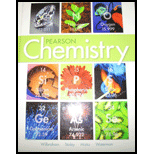
(a)
Interpretation: The names for the given ionic compounds are to be examined and if the names are incomplete then the complete name is to be given.
Concept Introduction : Molecular compounds are formed by the sharing of electrons between non-metals. They are known as carbon compounds. The naming of the compound is
Ionic compounds are formed by the transfer of electrons between metal and non-metal. They are named as
(a)
Answer to Problem 97A
The formula is
Explanation of Solution
The given name of ionic compound is copper sulfide. It is composed of
(b)
Interpretation: The names for the given ionic compounds are to be examined and if the names are incomplete then the complete name is to be given.
Concept Introduction : Molecular compounds are formed by the sharing of electrons between non-metals. They are known as carbon compounds. The naming of the compound is
Ionic compounds are formed by the transfer of electrons between metal and non-metal. They are named as
(b)
Answer to Problem 97A
The formula is
Explanation of Solution
The given name of ionic compound is iron sulfate. It is composed of
(c)
Interpretation: The names for the given ionic compounds are to be examined and if the names are incomplete then the complete name is to be given.
Concept Introduction : Molecular compounds are formed by the sharing of electrons between non-metals. They are known as carbon compounds. The naming of the compound is
Ionic compounds are formed by the transfer of electrons between metal and non-metal. They are named as
(c)
Answer to Problem 97A
As lead exists in +2 and +4 oxidation state. The compound formulas are
Explanation of Solution
The given name of ionic compound is lead oxide. As lead exists in +2 and +4 oxidation state. The compound formulas are
Thus, the name of the compound is given as lead(II) oxide and lead(IV) oxide.
(d)
Interpretation: The names for the given ionic compounds are to be examined and if the names are incomplete then the complete name is to be given.
Concept Introduction : Molecular compounds are formed by the sharing of electrons between non-metals. They are known as carbon compounds. The naming of the compound is
Ionic compounds are formed by the transfer of electrons between metal and non-metal. They are named as
(d)
Answer to Problem 97A
As manganese exists in +2, +3 and +4 oxidation state. The compound formulas are
Explanation of Solution
The given name of ionic compound is manganese fluoride. As manganese exists in +2, +3 and +4 oxidation state. The compound formulas are
Thus, the name of the compound is given as manganese(II) fluoride, manganese(III) fluoride and manganese(IV) fluoride.
Chapter 9 Solutions
Chemistry 2012 Student Edition (hard Cover) Grade 11
- Topic: Photochemistry and Photophysics of Supramoleculesarrow_forwardTwo cations that exchange an electron in an interface, the exchange density is worth 1.39 mA/cm2 and the current density is worth 15 mA/cm2 at 25°C. If the overvoltage is 0.14 V, calculate the reaction rate and symmetry factor. Data: R = 8,314 J mol-1 k-1: F = 96500 Carrow_forwardWith the help of the Tafel line, it is estimated that the interchange density of the VO2+/VO2+ system on the carbon paper has a value of 3 mA cm-2. Calculate a) the current density if the voltage has a value of 1.6 mV and the temperature is 25°C. b) the beta value of the anódico process if the Tafel pendulum is 0.6 V at 25°C. Data: R = 8.314 JK-1mol-1, y F = 96485 C mol-1.arrow_forward
- Hi can you please help me solve this problem? thank youarrow_forwardAn electrode process takes place at a metal-solution interface. Indicate the current condition that must be met for Faradaic rectification to occur.arrow_forwardAt a metal-solution interface, an electron is exchanged, and the symmetry factor beta < 0.5 is found in the Butler-Volmer equation. What does this indicate?arrow_forward
 ChemistryChemistryISBN:9781305957404Author:Steven S. Zumdahl, Susan A. Zumdahl, Donald J. DeCostePublisher:Cengage Learning
ChemistryChemistryISBN:9781305957404Author:Steven S. Zumdahl, Susan A. Zumdahl, Donald J. DeCostePublisher:Cengage Learning ChemistryChemistryISBN:9781259911156Author:Raymond Chang Dr., Jason Overby ProfessorPublisher:McGraw-Hill Education
ChemistryChemistryISBN:9781259911156Author:Raymond Chang Dr., Jason Overby ProfessorPublisher:McGraw-Hill Education Principles of Instrumental AnalysisChemistryISBN:9781305577213Author:Douglas A. Skoog, F. James Holler, Stanley R. CrouchPublisher:Cengage Learning
Principles of Instrumental AnalysisChemistryISBN:9781305577213Author:Douglas A. Skoog, F. James Holler, Stanley R. CrouchPublisher:Cengage Learning Organic ChemistryChemistryISBN:9780078021558Author:Janice Gorzynski Smith Dr.Publisher:McGraw-Hill Education
Organic ChemistryChemistryISBN:9780078021558Author:Janice Gorzynski Smith Dr.Publisher:McGraw-Hill Education Chemistry: Principles and ReactionsChemistryISBN:9781305079373Author:William L. Masterton, Cecile N. HurleyPublisher:Cengage Learning
Chemistry: Principles and ReactionsChemistryISBN:9781305079373Author:William L. Masterton, Cecile N. HurleyPublisher:Cengage Learning Elementary Principles of Chemical Processes, Bind...ChemistryISBN:9781118431221Author:Richard M. Felder, Ronald W. Rousseau, Lisa G. BullardPublisher:WILEY
Elementary Principles of Chemical Processes, Bind...ChemistryISBN:9781118431221Author:Richard M. Felder, Ronald W. Rousseau, Lisa G. BullardPublisher:WILEY





